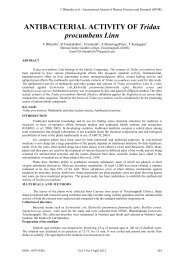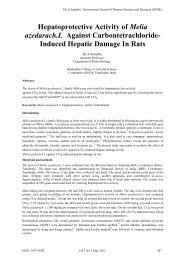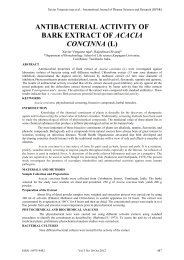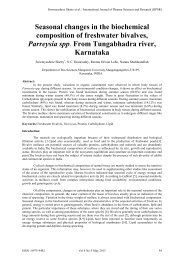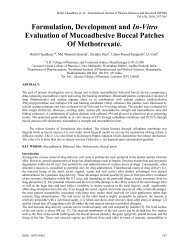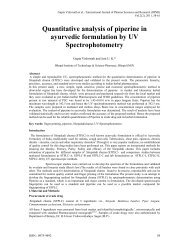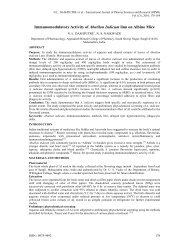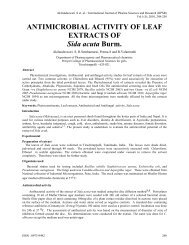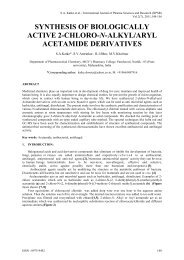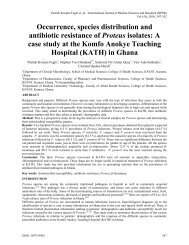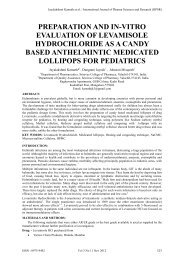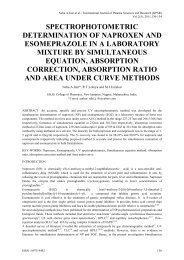evaluation of antidiabetic activity of triumfetta pilosa roth
evaluation of antidiabetic activity of triumfetta pilosa roth
evaluation of antidiabetic activity of triumfetta pilosa roth
Create successful ePaper yourself
Turn your PDF publications into a flip-book with our unique Google optimized e-Paper software.
D. Ramakrishna et al. / International Journal <strong>of</strong> Pharma Sciences and Research (IJPSR)<br />
Vol.2(3), 2011, 98-103<br />
EVALUATION OF ANTIDIABETIC<br />
ACTIVITY OF TRIUMFETTA PILOSA<br />
ROTH IN STREPTOZOTOCIN-<br />
INDUCED DIABETIC RATS<br />
* D Ramakrishna 1 , G Vidyasagar 2 , K Pavan Kumar 1 , I Madhusudhana Reddy 3 , VSS S Gupta<br />
Atyam 4<br />
1 Department <strong>of</strong> Pharmaceutical Sciences, JJT University, Jhunjhunu, Chudela, Rajasthan 333 001<br />
2 Department <strong>of</strong> Pharmaceutical Sciences, Veerayatan institute <strong>of</strong> pharmacy, Bhuj, Jakhania Kutch, Gujarat 370<br />
460<br />
3 Department <strong>of</strong> pharmaceutical chemistry, Malla reddy college <strong>of</strong> pharmacy, Dhulapally village, Hyderabad<br />
500014<br />
4<br />
Department <strong>of</strong> pharmacology, Joginpally B.R College <strong>of</strong> pharmacy, Yenkapally, Hyderabad 500072, India<br />
Abstract:<br />
The present study aims to evaluate medicinal use <strong>of</strong> Triumfetta <strong>pilosa</strong> for the treatment <strong>of</strong> diabetes. Antidiabetic<br />
<strong>activity</strong> <strong>of</strong> ethanolic extract <strong>of</strong> Triumfetta Pilosa Roth was evaluated for in-vivo hypoglycemic <strong>activity</strong> using<br />
Streptozotocin induced diabetic rats. Different biochemical parameters were used to determine the blood<br />
glucose levels using streptozotocin induced diabetes and analyzed it effect in kidneys after 21 days treatment.<br />
Ethanol extract had shown significant protection and lowered the blood glucose levels when compared to<br />
normal in glucose tolerance test. In kidney the changes caused after induction <strong>of</strong> diabetes showed degeneration’s<br />
in proximal tubular epithelial cells in the cortex <strong>of</strong> kidneys, hemorrhage in the interstitial area and<br />
periglomerular lympolytic infiltration and hyalinization <strong>of</strong> the arterioles which was reduced after feeding with<br />
Triumfetta Pilosa .Ethanolic extract <strong>of</strong> Triumfetta Pilosa prevented alteration in kidney pathology.<br />
Key Words: Triumfetta Pilosa, Antidiabetic <strong>activity</strong>, blood glucose, Kidney, Streptozotocin- Induced diabetes.<br />
INTRODUCTION<br />
Diabetes mellitus, is a chronic metabolic disorder characterized by a high blood glucose concentrationhyperglycemia<br />
(fasting plasma glucose > 7.0 mmol/l or plasma glucose > 11.1 mmol/l 2 hours after a meal) –<br />
caused by insulin deficiency, <strong>of</strong>ten combined with insulin resistance. The body has to maintain the blood<br />
glucose levels at very narrow range, which is done with insulin and glucagons. Insulin is a hormone produced<br />
by special cells (called beta cells) in pancreas. The pancreas is located deep in the upper part <strong>of</strong> the abdomen,<br />
behind the stomach attached to the duodenum. Therefore, the search for more effective and safer hypoglycemic<br />
agents has continued to be an important area <strong>of</strong> active research. Furthermore, after the recommendations made<br />
by WHO on diabetes mellitus, investigations on hypoglycemic agents from medicinal plants has become more<br />
important 1-4 .<br />
The plants and herbs are being used as decoctions or in other extracted forms for their blood sugar lowering<br />
properties. Many useful herbs introduced in pharmacological and clinical trials have confirmed their blood sugar<br />
lowering effect, repair <strong>of</strong> ß-cells <strong>of</strong> islets <strong>of</strong> Langerhans. There are some useful reviews on Indian medicinal<br />
plants having blood sugar lowering potentials. India is well known for its herbal wealth. Medicinal plants like<br />
Andrographis paniculata , Azadirachta indica, Ocimum sanctum, Trigonella foenum graecum,Swertia chirayita,<br />
Pterocarpus marsupium, Aegle marmelos, Helitropium zeylanicum, puntia ficus, Caralluma attenuata, Salacia<br />
reticulate, Raphanus sativus, Amarathus spinosus,have been studied for the treatment <strong>of</strong><br />
diabetes.However,detailed study on the efficacy, mechanism <strong>of</strong> action and safety <strong>of</strong> plant extracts are needed 5-7 .<br />
Many herbal medicines have been recommended for the treatment <strong>of</strong> diabetes. Traditionally plant medicines are<br />
used throughout the world for a range <strong>of</strong> diabetic conditions.The whole plant Triumfetta <strong>pilosa</strong> Roth, family<br />
tiliaceae is traditionally used for Antidiabetic. The present study is an attempt to investigate Antidiabetic<br />
<strong>activity</strong> on ethanolic extract <strong>of</strong> plant Triumfetta <strong>pilosa</strong> Roth. as to provide a scientific pro<strong>of</strong> for the <strong>activity</strong>.<br />
ISSN : 0975-9492 98
D. Ramakrishna et al. / International Journal <strong>of</strong> Pharma Sciences and Research (IJPSR)<br />
Vol.2(3), 2011, 98-103<br />
MATERIAL AND METHODS<br />
Collection <strong>of</strong> plant<br />
The dried plant <strong>of</strong> Triumfetta <strong>pilosa</strong> Roth. was collected from Herbal garden Tirupathi, Andhra Pradesh, India in<br />
the month <strong>of</strong> January 2009 and authenticated by Dr. K. Madhav Chetty, Assistant Pr<strong>of</strong>essor, Dept. <strong>of</strong> Botany,<br />
Sri Venkateswara University, Tirupathi, Andhra Pradesh. The whole plant was cleaned, air dried and grounded<br />
into powdered separately. The dried powdered plant material was passed through sieve 60 and stored in air tight<br />
containers.<br />
Preparation <strong>of</strong> extract<br />
The dried powder <strong>of</strong> Triumfetta <strong>pilosa</strong> plant (200gms) was successively extracted with Ethanol (80%) at room<br />
temperature by Soxhlet extraction process. Each time before extracting with the solvent, dry the powdered<br />
material in oven below 50⁰c. Concentrate the extract at reduced pressure by Rotary Flash Vacuum Evaporator.<br />
Weigh the extract obtained with the solvent and calculate its percentage in terms <strong>of</strong> the air-dried weight <strong>of</strong> the<br />
plant material. Further the concentrated extract was dried in desiccator and stored in vacuum sealed air tight<br />
containers. The extract was suspended in 0.9% normal saline as a vehicle solution and is used 8 .<br />
Test animals<br />
Male wistar albino rats (160 – 200 g) were used in the experiment. Animals maintained under standard<br />
environmental conditions, were fed with a standard diet (Hindustan Lever, India) and water ad libitum. The<br />
animals were fasted for 16h before experimentation but allowed free access to water. All the chemicals were for<br />
study were analytical grade.<br />
THE FIVE GROUPS ARE AS FOLLOWS:<br />
Group I: Normal control rats received normal saline as a vehicle p.o.<br />
Group II:<br />
Diabetic control rats received normal saline p.o.<br />
Group III: Diabetic + Effective dose 100mg/kg b.w <strong>of</strong> whole plant extract in<br />
normal saline p.o.<br />
Group IV: Diabetic + Effective dose 200mg/kg b.w <strong>of</strong> whole plant extract in<br />
normal saline p.o.<br />
Group V: Diabetic + glibenclamide (2.5 mg/kg b.w) in normal saline p.o.<br />
BIOCHEMICAL TESTS<br />
After 21-days treatment, blood from all the groups were collected by retro-orbital puncture under mild<br />
anesthesia for estimating blood glucose levels , total cholesterol levels, total triglyceride levels , serum urea,<br />
serum creatinine, serum insulin levels , HDL, LDL & VLDL levels. Then the animals <strong>of</strong> all groups’ kidneys<br />
were decapitated, isolated and fixed in 10% neutral formalin for histology.<br />
Acute Toxicity Studies:<br />
In acute toxicity study, there were no behavioral changes seen up to 4hrs and no mortality was observed up to<br />
the end <strong>of</strong> 48hrs even at the maximum tested dose level <strong>of</strong> 2000mg/kg per oral, it is considered as LD50. Thus,<br />
1/10 th <strong>of</strong> LD50 is taken as the effective dose. As a result, two doses <strong>of</strong> 100mg/kg and 200 mg/kg b.w was taken<br />
as an effective dose for the study 9-10.Different biochemical data were represented in table 9-10<br />
Table 1: Glucose Tolerance Test<br />
GROUPS 0 min 30 min 90 min 150 min<br />
Control (normal saline) 101.43±5.7 191.8±2.0 312.8±33.7 304.2±35<br />
Extract treated (T.p)<br />
(100 mg/kg)<br />
Extract treated (T.p)<br />
(200 mg/kg)<br />
97.4±5.7 113.8±2.3** 78.2±9.17** 89.4±10.3**<br />
93.3±3.3 106.5±33.4** 72.4±11.5*** 79.6±11.3***<br />
ISSN : 0975-9492 99
D. Ramakrishna et al. / International Journal <strong>of</strong> Pharma Sciences and Research (IJPSR)<br />
Vol.2(3), 2011, 98-103<br />
Extract Treated = Triumfetta <strong>pilosa</strong> (T.p) Plant<br />
Values are given as mean ± SEM for groups <strong>of</strong> six animals in each group.<br />
Extract treated rats were compared with normal control rats.<br />
*P
D. Ramakrishna et al. / International Journal <strong>of</strong> Pharma Sciences and Research (IJPSR)<br />
Vol.2(3), 2011, 98-103<br />
Extract Treated = Triumfetta <strong>pilosa</strong> (T.p) Plant<br />
Values are given as mean ± SEM for groups <strong>of</strong> six animals in each group.<br />
Diabetic control rats were compared with normal control rats. Diabetic + Triumfetta <strong>pilosa</strong> and Diabetic +<br />
glibenclamide treated rats were compared with Diabetic control rats.<br />
ANOVA followed by Dunnet’s t-test.<br />
*P
D. Ramakrishna et al. / International Journal <strong>of</strong> Pharma Sciences and Research (IJPSR)<br />
Vol.2(3), 2011, 98-103<br />
Extract Treated = Triumfetta <strong>pilosa</strong> (T.p) Plant<br />
Values are given as mean ± SEM for groups <strong>of</strong> six animals in each group.<br />
Diabetic control rats were compared with normal control rats.<br />
Diabetic + Triumfetta <strong>pilosa</strong> and Diabetic + glibenclamide treated rats were compared with Diabetic control<br />
rats.<br />
ANOVA followed by Dunnet’s t-test.<br />
*P
D. Ramakrishna et al. / International Journal <strong>of</strong> Pharma Sciences and Research (IJPSR)<br />
Vol.2(3), 2011, 98-103<br />
further. The maximum value <strong>of</strong> 312 mg/dl was seen at the 90 th minute. Whereas in the extract treated animals,<br />
only a little elevation in the blood glucose were seen and maximum glucose tolerance was observed at 90 th<br />
minute. The extract was evaluated for in-vivo hypoglycemic <strong>activity</strong> using Streptozotocin at a dose <strong>of</strong> 60mg/kg<br />
body weight by i.p. route. 7 days after STZ injection, it was observed that there was a short phase <strong>of</strong><br />
hypoglycemia followed by marked elevation in the blood glucose level, the diabetic rats with fasting blood<br />
glucose levels > 250 mg/dl, were selected for further studies. This is in accordance with the reports published by<br />
various authors where the increase in glucose levels has been attributed to the destruction <strong>of</strong> β cells by<br />
Streptozotocin. Damage to the Beta cells is associated with the liberation <strong>of</strong> stored insulin after which the<br />
insulin synthesis is stopped leading to a persistent diabetic state. Since insulin is no longer available, glucose<br />
absorption is impaired leading to hyperglycemia. In addition, after 21 days <strong>of</strong> treatment, the Serum insulin levels<br />
<strong>of</strong> the treated diabetic rats were significantly enhanced compared to the untreated diabetic rats. It was observed<br />
that there was an increase in Serum Urea and Serum Creatinine levels in streptozotocin induced diabetic rats.<br />
However after 21 days administration <strong>of</strong> ethanolic extract <strong>of</strong> Triumfetta <strong>pilosa</strong> has led to a significant fall in<br />
Serum Urea and Serum Creatinine levels when compared with the standard group. It was observed that there<br />
was an increase in Serum Total Cholesterol(TC), Serum Total Triglycerides(TG), LDL and VLDL levels and<br />
decrease in HDL levels in diabetic rats. After continuous administration <strong>of</strong> ethanolic extract for 21 days has led<br />
to significant decrease in Serum Total Cholesterol, Serum Total Triglycerides, LDL and VLDL levels, while it<br />
increased HDL levels in diabetic rats. The beneficial effect <strong>of</strong> Triumfetta <strong>pilosa</strong> and glibenclamide given<br />
immediately after diagnosis <strong>of</strong> diabetes which decreases serum urea, serum creatinine, serum total cholesterol,<br />
serum total triglycerides, LDL and VLDL levels and increases Serum Insulin and HDL levels was observed<br />
after 21 days treatment. Hence, the results indicate that treatment <strong>of</strong> diabetic rats with Triumfetta <strong>pilosa</strong> Roth.<br />
Prevented the alteration in kidney pathology with the return to their normal texture as shown in figures 1-5.<br />
References:<br />
[1] T. D. Joseph, Text Book <strong>of</strong> Pharmacotherapeutics, 6 th Edition, 2007, 1335-1336.<br />
[2] R.K. Sharma, R.Arora. Traditional Medicine: A Novel Approach for available and affordable Health care.In: Herbal Drugs: A First<br />
Century perspective 1st ed. New Delhi: Jaypee B<strong>roth</strong>ers Medical Publishers Pvt. Ltd.; 2006,828.<br />
[3] J.F.Morton.Notes on distribuition, propogation and products <strong>of</strong> Borassus palms. Economic Botany Economic Botany 1988;<br />
42(3):420-41.<br />
[4] G.Subbalakshimi, M.Naik.Indegenous foods in the treatment <strong>of</strong> diabetes mellitus. Bombay hospital journal.2001, 43:4-22. .<br />
[5] B.Patwardhan, A.D.B.Vaidya, M.Chorghade.Ayurveda and Natural Products Drug Discovery. Current Science 2004, 86(6):789-99.<br />
[6] P.Mukherjee, A.Wahile A. Integrated approaches towards drug development from ayurveda and other Indian system <strong>of</strong><br />
medicines.J.Ethnopharmacol.,2006,105:25-35.<br />
[7] C.K.Kokate, Practical Pharmacognosy, 4 th Edition, 1997, 71-73.<br />
[8] N.R Famsworth.Biological and Phytochemical screening <strong>of</strong> plants.J.Pharm Sci., 1966; 55(3):225-76.<br />
[9] T.Chidambaram, T.Kumarappan, T.Nageswara Rao and C.Subhash .Polyphenolic extract <strong>of</strong> Ichnocarpus frutescens modifies<br />
hyperlipidemia status in diabetic rats.J.Cell and Microbiology. 6(2):175-187.<br />
[10] T.Nageswara Rao, C.T.Kumarappan , S.L.Mohana , C.Subhash.Antidiabetic <strong>activity</strong> <strong>of</strong> leaves <strong>of</strong> Talinum portulacifolium in Alloxan-<br />
Induced Diabetic Rats.Pharmacologyonline.,2007,407-417.<br />
ISSN : 0975-9492 103



